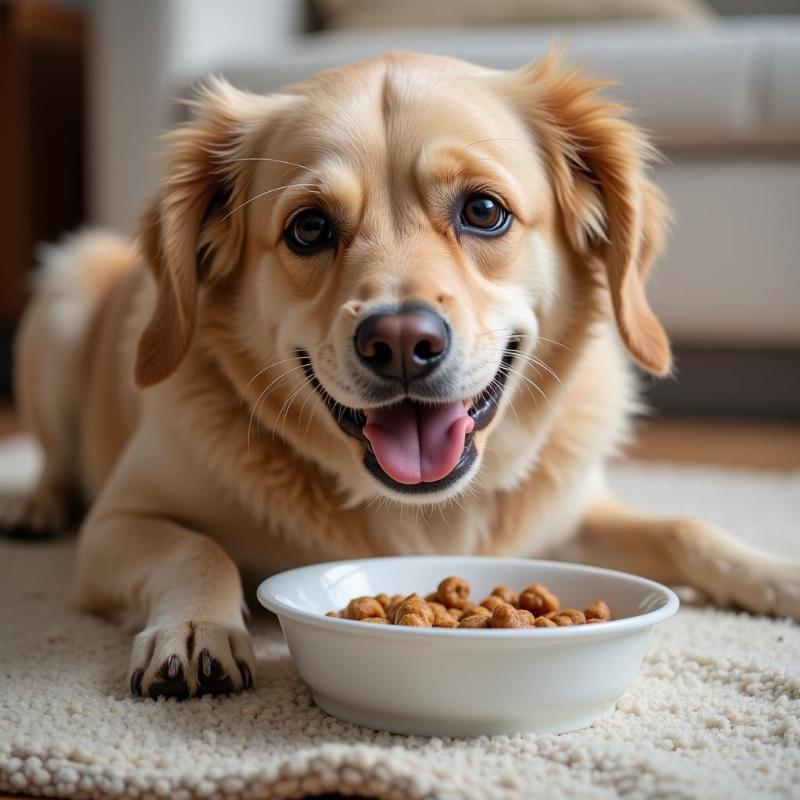Losing teeth is a common occurrence in senior dogs, and it can significantly impact their ability to eat comfortably. This transition can be challenging for both the dog and owner, but with the right soft dog food, you can ensure your furry friend continues to receive the necessary nutrients without pain or discomfort. Choosing the best soft food for dogs with no teeth requires careful consideration of ingredients, texture, and palatability. Let’s explore the options and provide you with the information you need to make the best choice for your toothless companion.
Choosing the Right Soft Dog Food for Your Toothless Companion
 Choosing soft food for a toothless dog
Choosing soft food for a toothless dog
When selecting soft food for dogs with no teeth, several factors come into play. First and foremost is the texture. The food should be easily mashed with a fork or even break apart with gentle pressure. Think of consistencies like pate, mousse, or very small, soft kibble. Avoid anything dry, crunchy, or chewy. Secondly, consider the nutritional value. Senior dogs have different dietary needs than younger dogs, so look for food specifically formulated for their age and health requirements. Ingredients like glucosamine and chondroitin can support joint health, while omega fatty acids contribute to healthy skin and coat. Finally, don’t underestimate the importance of flavor. Even if the food is soft, a picky eater might turn up their nose if it doesn’t taste good.
Types of Soft Dog Food for No Teeth
There’s a wide range of soft dog food options suitable for toothless dogs. Canned food is a popular choice, offering high moisture content and various flavors. soft food for dogs with no teeth comes in various textures, from chunks in gravy to smooth pates. Another option is soaking dry kibble in warm water or broth to soften it. This can be a good solution if your dog prefers kibble but struggles to chew it. Just make sure to monitor the soaked kibble and discard any uneaten portions after a few hours to prevent bacterial growth. You can also find specially formulated best food for dog with no teeth designed for senior dogs with dental issues. These diets often feature extra-soft textures and added nutrients to support overall health.
Homemade Soft Food Options
For pet owners who prefer a hands-on approach, preparing homemade soft food can be a rewarding experience. You can create nutritious and palatable meals by blending cooked meats like chicken or beef with vegetables and rice. Always consult with your veterinarian before transitioning to a homemade diet to ensure it meets your dog’s specific nutritional requirements. Remember to avoid ingredients that are toxic to dogs, such as onions, grapes, and chocolate.
Tips for Feeding a Dog With No Teeth
Beyond choosing the right food, there are several ways to make mealtimes easier and more enjoyable for your toothless dog. Using shallow bowls can make it easier for them to access the food without straining their neck. You can also warm the food slightly to enhance its aroma and palatability. If your dog is still struggling to eat, consider hand-feeding or using a food puzzle toy designed for soft food. These toys can stimulate their minds and provide a sense of accomplishment.
Transitioning to Soft Food
When switching to soft food, do it gradually to avoid digestive upset. Start by mixing a small amount of the new food with their current diet and gradually increase the proportion over several days. Monitor your dog for any signs of digestive issues, such as vomiting or diarrhea, and adjust the transition accordingly.
Conclusion
Finding the right soft dog food for dogs with no teeth can make a world of difference in their quality of life. By understanding their needs and exploring the available options, you can provide your senior companion with nutritious, palatable meals that they can enjoy without any dental discomfort. Remember to consult with your veterinarian for personalized recommendations tailored to your dog’s specific health condition.
FAQ
-
Can dogs live without teeth? Yes, dogs can live comfortably without teeth. With the right diet and care, they can continue to thrive.
-
What human food can I give my dog with no teeth? While some human foods are safe for dogs, always consult your veterinarian before introducing new foods into their diet. Cooked chicken, plain yogurt, and pureed vegetables can be good options, but avoid anything seasoned or processed.
-
How do I know if my dog’s food is soft enough? The food should be easily mashed with a fork or break apart with gentle pressure.
-
Is it okay to only feed my dog soft food? Yes, as long as the soft food is nutritionally complete and balanced.
-
What are the signs that my dog is having trouble eating? Drooling excessively, dropping food, or avoiding meals altogether can indicate dental discomfort.
-
How often should I feed my dog with no teeth? Most senior dogs do well with two smaller meals per day.
-
Can my dog still enjoy treats if they have no teeth? Yes! Peanut butter sticks for dogs are a great option, as well as other soft treats specifically designed for senior dogs.
Related Articles
About Beautdogs.us
Beautdogs.us is your premier source for all things dog-related in the US. We offer expert advice on dog breeds, care, nutrition, and lifestyle, providing valuable resources for both new and experienced dog owners. Our goal is to empower you with the knowledge and tools to ensure your canine companion lives a long, healthy, and happy life. From selecting the best soft food for dogs with no teeth to understanding their unique breed characteristics, Beautdogs.us is your trusted partner in navigating the joys and responsibilities of dog ownership. Contact us at [email protected] or call us at +1 501-555-7529 for personalized guidance and support.